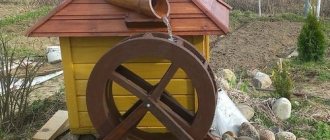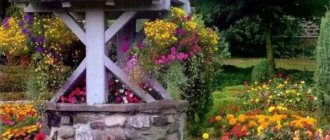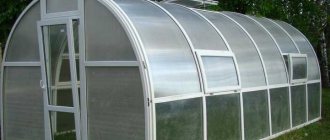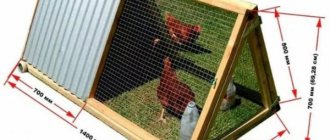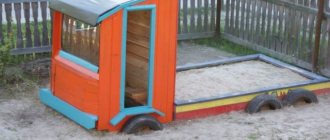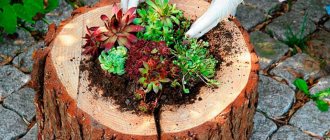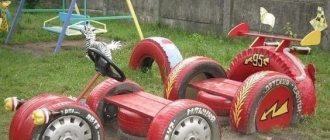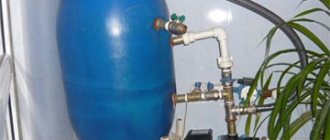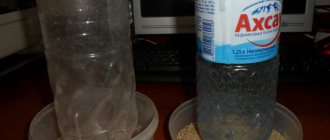One of the most beautiful decorative garden buildings is a water mill. You can watch it endlessly, and the murmur of water calms and relaxes.
This beauty will bring a lot of pleasure to its owner. An unusual structure will make everyone admire your site.
to build a decorative mill on your own that will run on water. The main condition for its construction, unlike a windmill , is the obligatory presence of a falling stream, natural or man-made. Let's take a the manufacturing process of a simple water mill.
Water mill device
Details of decorative mills may vary depending on the size of the structure and design, but the basic design elements remain the same:
- Wheel with blades (the main part that moves water);
- Gutter (structure for supplying water to the wheel);
- Axle and hinges;
- Support frame for the wheel (if the mill has a house, then the support is placed on one side only);
- building (the house next to the wheel) is built if the size of the summer cottage, reservoir or pond, personal time and finances allow.
Important! A building with a real house, which stands next to the wheel, looks more aesthetically pleasing and complete.
Principle of operation
Water flows onto the mill wheel, rotating it. It flows out from the other side.
If there is a reservoir or pond, the water will circulate in a circle. It can rise to the top point of the wheel using a pump.
Types of water mills
This device was known in ancient times; the following types are distinguished according to the type of wheel orientation:
- vertical;
- horizontal.
In the first case, the mechanism is driven by a water wheel located in a vertical plane through a gear mechanism, and the horizontal orientation implies the absence of such a principle.
According to the purpose of use, water mills can be flour mills, sawmills, and also created for paper production and the needs of the textile industry. However, in a summer cottage they serve only a decorative function.
The mechanism of a vertical water mill is driven by a water wheel located in a vertical plane through a gear mechanism.
A complete water mill consists of the following parts:
- wheel with blades;
- groove, axle and hinges;
- wheel frame;
- frame.
This device has been mentioned in ancient books and other sources since time immemorial; it was built over the centuries to process grain into flour. So, the product was lifted upstairs, from where it was poured into millstones along a chute, and people collected the finished raw materials for baking bread into bags.
Despite the invention, the process of grinding grains still remained a difficult task. The improved device directs natural water from the reservoir to the wheel, and the force of the falling liquid sets in motion the blades of the wheel, which rotates the axis of the mill.
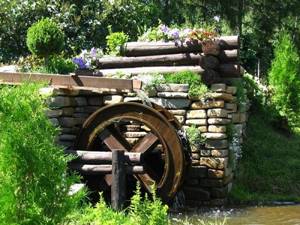
Today, you can create a smaller version of this device with a little imagination and effort. There are many decorative options for a water mill; for example, it can be made from materials available to everyone: stone, wood, broken brick. Some gardeners make not only a wheel, but also a house with a roof made of straw or reeds; this composition fits perfectly into the overall appearance of the site.
Also read: Crazy hands: flower beds made from tires in your dacha
The building located next to the structure can be used as storage for gardening tools. In addition, the water flow makes it possible to obtain energy, so using a mill can actually illuminate a path or water a garden. A water mill, decorated with plants, especially conifers and shrubs, will add mystery to the suburban area and perfectly complement it.
Materials and tools
The building is made of wood. To create a decorative water mill you need:
- pencil, pen, marker, compass (for drawings and marking parts);
- square (right angle ruler), simple long ruler;
- sanding machine or sandpaper (medium grit);
- jigsaw (simple or electric), saw;
- self-tapping screws, nails, screws, bolts and washers of different sizes;
- drill, drills of various shapes and thicknesses;
- screwdrivers (Phillips and simple) or screwdriver (electric or cordless);
- meter, measuring tape;
- hammer.
The required amount of materials is determined in accordance with the size of the building. For the mill you will need:
- plywood;
- bars of various sizes;
- wooden slats (they will connect all the walls and roof of our building);
- coil or other round structure (for making a wheel);
- metal rod , aluminum tube and bushings (for fastening and rotating the wheel);
- for the roof you can use plywood and any roofing material (for example, tiles);
- material for lining the mill body;
- hose (for attaching it to the gutter, and also if an underground key device is necessary);
- materials for decoration (tiles, stones, windows, doors, etc.);
- special glue for wooden products;
- impregnation, varnish, enamel for woodwork.
Attention! Calculation of materials must be carried out with a small margin for defects and unintentional breakdowns.
Site preparation
To build a building, the first thing you need to do is choose a suitable location and prepare it. The area should be cleared and should be planned .
The ideal place to install a water mill is the bank of a stream or river: flowing water creates a constant torque for the wheel.
But since our mill is decorative, it can be built on any garden plot. A small pond is enough for the wheel to function .
If the reservoir is already equipped, then there should be no problems with installing the building. But if you are just going to build a pond and a water mill in it, then the following tips will be useful to you:
- You should not locate a pond with a mill in places with a large concentration of trees and bushes;
- the place should be well ventilated;
- if there are uneven places on the site, then it is better to build a mill on them;
- humidity and wet soil near the water mill
An artificial waterfall is an excellent solution for a summer cottage. Read here how to make it yourself. Trellis for climbing plants will decorate your summer cottage and divide it into zones.
Creating an Artificial Flow
to supply water to the mill wheel. Artificial flow device options:
- Installing the wheel under the gutter from the drain. The mill will only work when it rains outside. You can attach a hose with a pump to the structure, which will constantly supply water to the gutter. The flow of water coming out of the wheel can be used for other purposes;
- To create a falling flow, you can adapt the unevenness of the site (natural alpine slide). At a short distance from the building, it is necessary to create a place to collect water, which will be supplied to the wheel through a chute;
- On a flat surface you can build an artificial alpine slide. To create it, use cinder blocks, bricks, large stones or well-compacted soil. One of the options for constructing such a slide is to install a hose inside. It is filled with stones, making a decorative underground key. Water from the spring is also supplied through a chute to the mill wheel;
- Installing a pump in a water reservoir (tank, well, well, reservoir, pond, etc.). Under pressure, water flows through a hose onto the wheel, ensuring its movement. a hole in the chosen place and dig a tank into it or cover it with film;
- Installing a reservoir with water and a hose (or gutter) above the level of the future mill.
An example of installing a water mill next to an artificial alpine slide can be seen in this video:
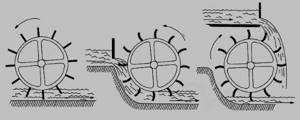
Ways to create water flow:
1. Installation under the drain will be the easiest way, but with the biggest disadvantage, because... The mill will only rotate when it rains.
2. The use of hills on the site will make it possible to create a water collection area under which it is convenient to locate the mill.
3. Artificially created alpine slides containing a hose are ideal for decorative mills. Through it, with the help of a pump, water will be supplied from the hill.
4. A ready-made reservoir with a pump is considered the most common option; the hose is simply fed to the gutter, if possible decorated or hidden in the mill house.
To create a decorative mill with our own hands, we will need: a pencil, a ruler, a jigsaw, self-tapping screws, a drill or screwdriver, plywood, bars and slats of different thicknesses, a hose, a pump, wood glue, impregnation, enthusiasm and straight hands.
Stages of making a water mill
First of all, we draw a sketch of the future building. Decide in advance what you will make the water wheel of your mill from, because the house must match it in size, otherwise the structure will look ridiculous, or even not be able to function at all.
Wheel
The most important part of a water mill is the wheel. To make it, you can use any round-shaped object. It can be:
- wire coil ;
- wheels from a bicycle or car;
- plastic wheels from toys;
- plastic pipe with fastened ends and attached blades.
You can make your own wheel from solid wood or moisture-resistant plywood.
The design of the wheel consists of two disks or equal diameter , between which the blades are attached.
The blades can be made of wood, plywood or aluminum angle. They are glued at equal intervals.
A piece of metal tube for the axle in the center with the help of which it will be attached to the mill body on one side and to the support on the other. We assemble the support for the water wheel from bars.
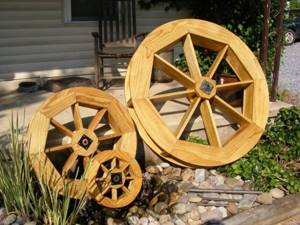
House
Next, we make the body of the water mill. For the base, you can use paving slabs and stones or make it out of wood, like a house.
Step 1. We cut the slats exactly to the dimensions of our mill.
Step 2. Assembling the frame of the house. Corner joints are made by cutting half-wood.
Step 3. We cover the frame with clapboard or lath.
Step 4. Assembling the roof frame.
Step 5. We make the roof slopes from plywood, and on top they can be covered with some kind of roofing material. For example, cutting mini shingles from asphalt shingles.
Step 6. Carefully sand all wooden structural elements with sandpaper or a sanding machine. It is worth paying attention to the ends and side sections.
Impregnation of wooden parts
Impregnation should be done with special compounds (Senezh, Belinka and others). They protect the tree from precipitation, various types of fungi and mold, and insects.
We carefully treat all parts with protective impregnation, because the mill will be in constant contact with water. For best protection, it is necessary to impregnate in 3-5 layers, allowing each to dry completely.
Attention! Some antiseptics can be toxic and must be handled with precautions.
Installation
We assemble all parts of the mill into a single structure.
We install the mechanism for attaching the wheel to the house. To do this, you need to drill a hole in one of the walls and insert an axle there.
One piece of aluminum pipe, put on the axle, serves as a spacer sleeve, the other strengthens the hole in the wall.
The clearance between the wheel and the support, necessary for free rotation, is provided by another spacer sleeve.
We secure the structure
with a nut screwed onto the end of the rod.
The result is the following:
- A reservoir of water (from which it flows to the wheel);
- Hose or gutter (for water supply);
- A mill consisting of a house and a wheel;
- Place of drainage (where it goes after the wheel).
Working principle of a water mill
As a rule, water for this device comes from a reservoir - a river, pond or reservoir through a pipe, moving to the wheel. Its powerful flow sets in motion the blades of the wheel, which rotates the axle. The full-size water mill is designed in such a way that the passage of liquid is controlled by sluice gates, which prevent flooding. The decorative device works on a similar principle. Water from the country pond flows onto the wheel from above, the force of the falling liquid acts on the blades, and it begins to rotate.
Water is supplied through a hose, one end of which is placed in the pond, and the other is brought to the roof of the mill. The liquid is distilled by a pump, thanks to which it circulates in a circle and causes the wheel to move.
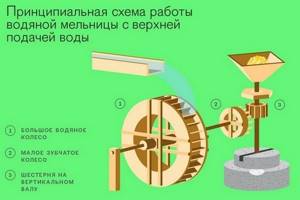
Water from the country pond flows onto the wheel from above, the force of the falling liquid acts on the blades, and it begins to rotate
Water mill design
The building will take on a finished look only after decorating the house and the surrounding area. There are many design options for water mills. Let's look at the most common of them.
Country
rustic design .
Wooden parts predominate. Near the mill you can build a mini-bench from a solid log or build log gazebo, a children's house, a wooden decorative cart with flowers, and various wooden figurines.
Flowers should be simple, nothing exotic (chamomile, sunflower, etc.).
Half-timbered
To equip a mill in this style, you will need metal tiles for the roof, white and brown paints (you can use wood impregnation instead of brown) for the walls, and decorative thin slats (must be treated with the same paint or impregnation).
The house is painted white, then decorative slats are glued on top, breaking the surface into small squares and triangles. The resulting facade looks very picturesque.
Next to the mill you can place a dark (brown or black) bench with a back, a brown or white flower bed. Flowers are planted in dim shades.
Decorative water mill on the site
Miniature windmills, created with your own hands in an artificial reservoir, are not uncommon in suburban areas today. Just like a waterfall, a mill enlivens the landscape, and a water wheel and its engine - the flow of water - can be built by understanding the simple diagram of how a water wheel works.
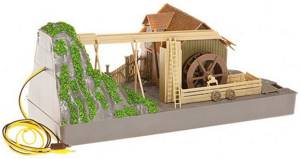
The first mentions of water mills date back to the 13th century, and the mechanisms were functional and powerful - they ground grain. Associations with flour, fairy tales, baked bread and other attributes of mills are not accidental, since even a miniature purely decorative mill carries powerful positive energy; the murmur of water and the rotation of the wheel enliven the pond and create a special atmosphere of peace.
To set up a mill, you will need consumables and equipment: a water pump of the simplest design, a piece of water hose, auxiliary material - old blinds, a wheel from a wire coil, an old broken grinder, sealant, plumbing fittings and sealants, straw or reeds. But there are many designs of mills, so the set of materials may be different. In any case, the basis of all mills is the same: all mills consist of a house and a water wheel.
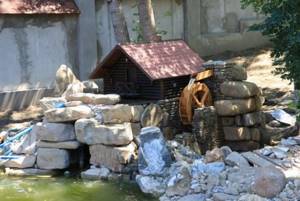
To build a house, you can use a metal box, covering it with reeds or wooden planks. The roof can be made of straw. Houses made of stones, plywood sheets or wooden planks are possible. For heavy versions of stone mills, it will be necessary to build a shallow foundation - 25-30 cm. Use materials at hand as a frame, for example, old plastic buckets, covering them with stones and fastening them with cement-sand mortar. The pump is inserted inside the box and strengthened, and the middle of the wire coil is suitable for the wheel. By disassembling an unnecessary angle grinder, you can get an excellent mechanism for rotating the wheel; skilled summer residents make screws from old blinds.
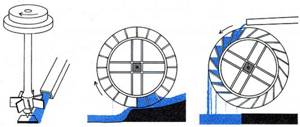
Waterproof plywood is suitable for the wheel. Cut out circles of the required diameters and make central holes. For the spokes, rectangles are cut out of the same plywood and attached to the circles of the future wheel. Having secured the finished mill wheel in the vertical supports, insert the central dowel rod with a small protrusion. The seams are treated with wood glue and freedom of rotation is checked.
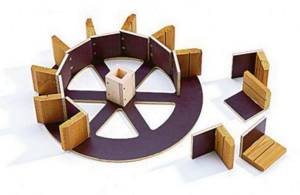
The operating principle of a water mill is simple: pond water flows onto the wheel, and the force of the falling water causes the wheel to rotate, acting on its blades. As an option, water is supplied through a hose, placing one of its ends in the pond, and bringing the other to the level of the mill roof and masking it there, while a pump installed in the house pumps water. This scheme is the simplest; more interesting are mills not with one wheel, but with a cascade.
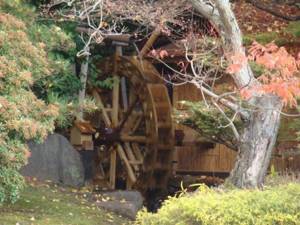
The style of a decorative mill is even more important than its design and must be consistent with the overall style of the landscape. Classic water mills have stone houses and forged parts; the wheel may be made of metal. A rustic-style mill can be made entirely of wood, with plants and flowers complementing the design.
